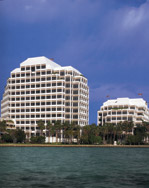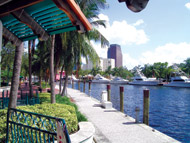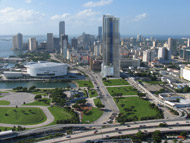|
CITY HIGHLIGHT, JUNE 2005
MIAMI’S EXCELLENT ECONOMICS
 |
Within Miami’s CBD, strong demand has squeezed availability of large blocks of contiguous quality space to a minimum. Courvoisier Centre, located on the exclusive Brickell Key island, is well positioned to accommodate a user requiring 20,000 square feet or more.
|
|
Florida and South Florida maintained strong residential expansion in terms of new development, sales and escalating pricing. Coldwell Banker ranks the state second in the nation in luxury home sales volume, following California. The Florida Association of Realtors reports a near 88 percent increase in existing single family sale prices over the last 5 years for the state, while the South Florida region posted a 33 percent increase just over the last year alone. Despite the robust growth rates among the three counties, Miami-Dade may be seeing a market correction as it had the “sharpest decline in home sales and the smallest increase in prices,” according to the South Florida Business Journal. However, on the condominium front, an unprecedented development boom persists in Miami with over 55,000 residential units in some phase of development; further, The Herald reports that “this number is increasing monthly.” This statistic is startling considering only 7,000 condominium units have been built over the last decade.
Correspondingly, business expansion and confidence in the local economy also fared well with January unemployment posting one of the lowest rates in four years — under 5 percent for the Miami area. In addition to construction and hospitality, business and professional services — a prime office user — also contributed to new hiring.
Office Market Performance Trending Up
These accolades are translating into exuberant confidence in Miami’s office market sector. With increased leasing activity and stabilized rental rates among competitive trophy towers, first quarter welcomed the year with announcements for two new Class A office tower projects planned for development. While both the suburban and central business district (CBD) sectors each will be the recipient of this new product and construction dates have been determined, no anchor tenants have yet to be announced.
Within the CBD, the trend of purchasing property and/or land at extremely high rates in favor of residential development continues. The prime beneficiary: existing office landlords that are seeing competition restricted which will provide a stronger platform for rental rate growth. Most of Miami’s landlord representatives with trophy assets in the city’s choice submarkets are anticipating a gradual dissolution of concessions this year, allowing for a strengthening in rental rates, which is occurring in both suburban Coral Gables and along Brickell Avenue in Miami’s CBD.
While headline news in the Airport area has been focused on Burger King’s relocation to Coral Gables for their new world headquarters, this submarket is garnering tours by some of the largest requirements in the city. Leasing activity, largely in the form of renewals and expansions, in both the Class A and Class B segments of the market is up substantially. However, despite increased demand, true rental rate growth is not anticipated until next year.
Good Vibes Anticipated Throughout 2005
The U.S. economy should deliver steady growth in 2005, with moderate yet solid increases in real estate demand, as forecasted by LaSalle Investment Management. Reflecting this trend and boding well for its office market, Florida was ranked as the “hottest job market in the country” by the end of the first quarter, with South Florida generating the most jobs and Miami being the winner with over 25,000 new jobs.
— Eric Groffman, vice president, Jones Lang LaSalle
Multifamily
For nearly a year, market analysts have warned that Miami’s boiling real estate market was degrees away from overheating. But, concerns of this looming bubble are far from developers’ and investors’ minds as the condominium craze continues. Miami-Dade County is witnessing an unprecedented level of condominium conversion activity and new condo development with approximately 23,000 units converted since January 2002 and 40 projects comprised of 11,000 units currently under construction, all of which have a total value of $4.1 billion. Another 175 projects with 51,000 units are in various planning stages in Miami-Dade County.
Due in part to the huge influx of foreign investors in the Miami market, land and Class A properties come at a premium. Much of the capital flowing into this market is coming from South America and Europe and in many cases, these investors are willing to pay more than other investors just to have a play in the market, driving prices up.
Leviev Boymelgreen, an Israeli-American developer, quickly has become one of the largest players in the market. He is behind the Marquis development, a 310-unit, Arquitectonica-designed, 63-story condominium tower in the Park West area of downtown.
Another notable development is the Paramount Park, a 68-story tower in Park West by Daniel Kodsi of Royal Palm Communities, one of the many developers leading the charge to redevelop this warehouse district. Kodsi owns approximately 7 acres of land in the Park West area.
Miami continues to be one of the hottest urban-infill, for-sale markets in the country. The majority of development is occurring in downtown Miami, Park West, Media and Entertainment District, and the Brickell area. In Miami-Dade County, new housing starts plunged 21 percent in the first quarter compared to the first quarter a year ago — a figure that excludes condominiums. This rapid decline can be blamed on a lack of land available for development in Miami-Dade County.
Despite some fear of this boiling market overflowing with too much product, the investment market should remain strong. Currently, there are many more buyers than there are desirable properties or land.
— Avery Klann, principal, Apartment Realty Advisors
Retail
The Miami Dade County retail market has performed well in recent years. Development in the county has centered for the most part in mixed-use projects in the Brickell and Kendall submarkets, with traditional shopping center building occurring in the extreme western and southern areas. With the rise of new residential subdivisions in these areas, it only makes sense that retail development will follow.
As such, it is not surprising that the vacancy rate for West Dade, Kendall and South Dade does not exceed 5 percent. The amount of space available for lease in the county has decreased for the second year in a row. The asking rental rate has not followed the same trend as it dipped by 6.3 percent, attributed mostly to the drop in the Miami/Miami Beach submarket.
The Buena Vista Yards consists of 56 acres of vacant land and is located south of N.E. 36th Street, north of 29th Street, west of N.E. Second Avenue and east of North Miami Avenue. The land will undergo redevelopment into a mixed-use project and is a partnership between Biscayne Development Partners LLC and Developers Diversified Realty. When finished, the project will consist of retail (known as the Shops at Midtown) and residential (known as Midtown Miami) components. The Shops at Midtown broke ground last May and will include 600,000 square feet of retail space. Midtown Miami will include 3,000 condo lofts and 350 apartment units. Miami is looking forward to the project's completion, as it will bring 1,700 permanent jobs to the area. Shops at Midtown should be successful, as it caters to an underserved market with no other big box retail centers located between Dadeland and Aventura.
Bank of America is planning on opening 23 new bank centers in South Florida by 2005 representing a $68.08 million investment for land, construction, personnel and building operations. The first in this wave of expansion is located in Coconut Grove and features an open sales floor and conference rooms. It has the appearance and feel of a retail business rather than traditional bank.
Wal-Mart has two parcels in northwestern Miami-Dade County under contract. The sites, which measure 30 and 40 acres, are approximately 3 miles apart. Wal-Mart is expected to construct a 203,000-square-foot Supercenter at both locations. The 30-acre site near Pro Player Stadium will be home to the first store in this area, while the 40-acre site should open its store in 2006.
In South Dade, the Cutler Ridge Mall will undergo a comprehensive remodel and has been renamed Southland Mall. T/S Development LLC, the management for the mall, recently announced Phase I of the project, which includes new shopping attractions and likely will include a multiplex movie theater, scheduled to open this year.
Downtown Dadeland, a “village within a city,” currently is under construction in the Kendall submarket. This mixed-use project will include 416 condo units and 125,000 square feet of retail space in several low-rise buildings. National retailers such as Pier 1 Imports, Chili's and Cargo will make Downtown Dadeland home.
The long-anticipated Mary Brickell Village is finally underway on 5.2 acres between Brickell Avenue and South Miami Avenue. The 192,000-square-foot project is intended to support Brickell area office workers and residents. Publix and Bally Total Fitness will anchor the retail portion, leasing 35,000 square feet and 25,000 square feet, respectively. A residential tower including 380 condo units and 810 parking spaces is also under construction. Brickell City Center and Coral Station on Brickell Way are two other mixed use projects scheduled for development in the area with a combined 90,000 square feet of retail space and more than 500 residential units.
The Design District, located just north of Downtown Miami, is slated to undergo significant redevelopment in terms of retail, residential and mixed-use construction. Dacra Companies made the first foray into this area years ago with projects on a smaller scale. Now, projects under consideration are estimated at $40 million and will contain three commercial buildings with retail space.
In Downtown Miami, the condo craze may adversely affect the retail market, at least in the short term. If the 10,800 residential units in various stages of planning become a reality in the area, the result will be two-fold — displaced retailers making way for condominium development and new retailers to moving into these new developments. For example, Columbus Bazaar was very popular with South American retailers and visitors in the late 1980s and into the 1990s. As these economies have waned, so has this retail center. The building is scheduled for demolition and will be replaced by Columbus Residential Towers. New retailers such as Whole Foods Market will make their first forays into Downtown Miami, locating in new residential buildings. This grocer will locate in Metropolitan Miami, an under-construction project that will contain approximately 150,000 square feet of retail space.
Miami-Dade County continues to be a very active retail investment market. In the past 12 months 14 strip centers were reported sold, with sales totaling more than 1.7 million square feet and a total value of approximately $200 million. Although Miami-Dade is the most densely populated of the three South Florida counties, it generally is perceived to be under-retailed. Thus, investor appetite for retail properties in this market results in frenzied buying, which drives prices higher and cap rates lower. For the first 6 months in 2004, Miami-Dade had the lowest strip center median cap rate of all Florida submarkets at 6.02 percent. One interesting sale of note this year was the Ratner Building on Miami’s elite Lincoln Road in South Beach. The 15,000-square-foot building sold for $12.6 million, or $810 per square foot, one of the highest sales per square foot transactions on record in Florida. This is not surprising, as Lincoln Road was once known as the “Fifth Avenue of the South” and now is South Beach’s creative district. Ann Taylor anchors The Ratner Building. The sale of Columbus Bazaar was a transaction of note this year. This 33,651-square-foot Neighborhood Center was bought by Cousins Properties for $11.5 million as a redevelopment site; Cousins plans to use this site to build a residential tower with ground floor retail.
— Trammell Crow Company
Investment
“Miami-Dade County is on the radar screen of every investment adviser in the world” is a quote heard throughout South Florida on a daily basis. Unquestionably, the Miami market ranks among the top five U.S. markets being pursued by investors, who constantly find themselves bidding prices up to true yields that approach 6 percent in some cases. It appears that there is no end to this across-the-board demand from pension funds, real estate investment trusts and individual investors.
All property types are considered desirable. Trophy office product was picked over from 2000 to 2004 so investors have turned their attention to Class B and C properties that are viewed as “value-ad” opportunities. Also, the investment community aggressively will pursue virtually any property — office, industrial and retail — that can be purchased below, or approaching, replacement value. Because of the region’s strong population growth, which shows no signs of slowing, retail properties are attaining prices never before seen in this market. Shopping center vacancies throughout South Florida are in the single digits.
Industrial market vacancies have decreased, although rents have remained fairly steady for the past decade. The industrial sector continues to be viewed as a very stable investment that will continue to do well even when an economic downturn occurs. Many developers who own land that historically was slated for development as bulk storage now are looking to develop flex office or distribution space. Often, this is sold as condominium space at prices ranging from $125 to $150 per square foot.
Certainly, the residential condominium market in Miami has garnered a great deal of attention throughout the world. With approximately 55,000 units planned for delivery in the area immediately surrounding downtown Miami in the next three years, many are questioning whether demand can keep up with supply. True believers predict that, given Miami’s popularity both domestically and internationally, demand will justify the development of these projects at prices ranging from $350 to as much as $1,000 per square foot. This development activity dramatically will alter Miami’s skyline over the next 5 years.
— Peter Harrison, senior vice president, Transwestern Commercial Services
Alaqua
GDC Premier Communities of Maitland, Florida, is developing Alaqua, a high-rise condominium community north of Miami in Aventura, Florida. With completion scheduled for March or April of 2006, the 193-unit property will feature a waterfront marina, a Mediterranean-designed courtyard with an oversized pool and heated spa, and fully finished units with 10-foot ceilings.
— Julie Fritz Hunt

|
NuRiver Landing
Noble House of Fort Lauderdale, Florida, and Carlyle Group of Chicago are developing NuRiver Landing in Fort Lauderdale. The 24-story, 409-unit condominium building is scheduled for occupancy fall 2005. Amenities include a lushly landscaped sixth floor Italianate Garden overlooking the riverfront and city park; a two-story, state-of-the-art fitness center; and a pool on the 25th floor.
— Julie Fritz Hunt

|
Paramount Park
Developer Royal Palm Communities is adding another property to its portfolio of “Paramount” brand of lifestyle destinations. Paramount Park, an upscale, mixed-use project located at 700 Biscayne Boulevard in Miami, will have a hip, urban vibe in a luxurious setting. Residences will have private elevators, unobstructed bay views and floor-to-ceiling glass.
Arquitectonica is designing the 65-story building, which will include 500 units as well as ground-floor retail and restaurant space. Construction is scheduled to begin in the second quarter of 2006.
— Julie Fritz Hunt

|
©2005 France Publications, Inc. Duplication
or reproduction of this article not permitted without authorization
from France Publications, Inc. For information on reprints
of this article contact Barbara
Sherer at (630) 554-6054.
|
